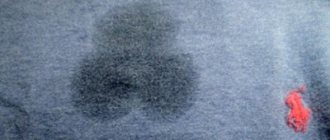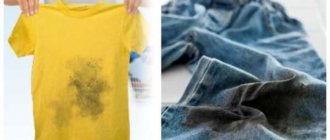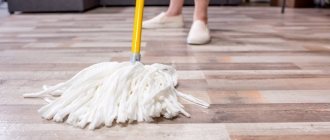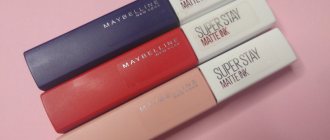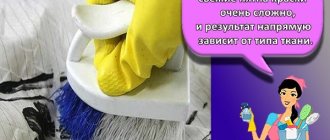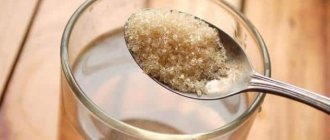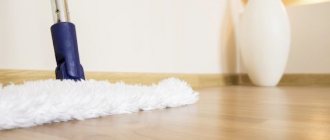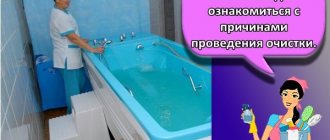The popularity of linoleum as a finishing material is explained simply. This inexpensive and practical floor covering is easy to maintain.
Linoleum can withstand frequent wet cleaning, cleaning with abrasive and chemical agents.
Regular cleaning allows you to maintain the original appearance of the floor covering. But what to do when hard-to-remove rust stains appear on the linoleum, how to wash them?
There are a sufficient number of folk methods and store-bought means for removing rusty stains.
Traditional recipes for use at home
Folk remedies will help you easily wash linoleum from rust stains.
Lemon acid
Cleaning with citric acid pulp will help quickly remove red stains from the floor covering.
Algorithm of actions:
- Dry citric acid powder is diluted with warm water to a thick paste.
- Apply with a soft sponge and gently rub the resulting product over the rust stain on the linoleum.
- The cleaned floor covering is wiped with a clean, damp, soft cloth.
Salt will help enhance the effect of citric acid. It is added and thoroughly ground in the already prepared cleaning composition.
Fresh lemon
A small piece of fresh lemon will not only help get rid of rust stains, but will also fill the room with a pleasant, refreshing aroma.
Algorithm of actions:
- cover the rust stain with a circle of fresh lemon and leave it for half an hour;
- Afterwards, wipe the linoleum with a cloth soaked in lemon juice.
Lemon juice is a gentle remedy, so to completely remove the stain, the cleaning procedure will have to be repeated several times.
How to remove with vinegar and ammonia?
A solution of ammonia and acetic acid can remove stubborn rust stains from linoleum.
Algorithm of actions:
- Dissolve 1 tbsp in 250 ml of warm water. acetic acid.
- The resulting product is generously moistened with a yellow rust stain.
- I additionally moisten the treated area with ammonia.
- The ammonia along with the stain is carefully wiped off with a soft cloth.
Work with ammonia and acetic acid is carried out only in a respirator, in a room with good ventilation. Otherwise, there is a high risk of respiratory tract burns and solvent vapor poisoning.
Kerosene
Kerosene will help remove old rust stains.
Algorithm of actions:
- the contamination is generously moistened with kerosene;
- Leave the rust stain for thirty minutes, then wash it off with clean, cool water.
Kerosene is an aggressive chemical that must be tested on an inconspicuous area (or remains) of the floor covering before application.
Baking soda
A universal folk remedy - baking soda will help you quickly get rid of traces of rust on linoleum.
Algorithm of actions:
- Baking soda is mixed with warm water to form a thick paste.
- Using gentle movements, wipe the rust stain with a soft rag or sponge with baking soda paste.
- The cleaned area of the flooring is washed off with warm water (remnants of baking soda are removed).
When mixing soda with water, you must ensure that the abrasive particles dissolve completely. Otherwise, scratches may appear on the linoleum.
Potassium salt
Remove old rust stains using potassium salt (tartar).
Algorithm of actions:
- in 2 tbsp. warm water dissolve 1 tbsp. potassium salt crystals;
- the resulting paste is applied to the stain and gently rubbed with a soft cloth or sponge;
- The already cleaned floor covering is additionally wiped with a clean damp cloth.
Work with potassium salt is carried out only with protective rubber gloves.
How to remove with carbonated water?
The secret to soda's effectiveness in fighting rust stains is simple. Sweet water (Coca-Cola is great) contains citric acid, which dissolves rust particles on linoleum.
Algorithm of actions:
- Using a spray bottle, sparkling water is sprayed onto the rust stain.
- After twenty minutes, the treated dirt is wiped off with a soft cloth or sponge.
If you don’t have a spray bottle on hand, you can simply cover the stain with a cloth soaked generously in sparkling water.
Features of mold formation under coating
Fungus under linoleum is a common phenomenon. Especially if the base is made of wood, such as fiberboard or chipboard. When using these materials, you need to understand that the risk of fungus formation is several times higher. There are always microorganisms in the air that are invisible to the human eye. By themselves, they do not pose any danger, but in the presence of favorable conditions, they enter the active phase and multiply.
Lack of oxygen, poor lighting, low temperature (less than 15 degrees), and high indoor humidity can contribute to the formation and rapid growth of mold. In such conditions, mold gradually occupies the entire space between the linoleum and concrete.
https://youtube.com/watch?v=coMCP3aS16M
How to restore the surface after cleaning?
Removing green stains from linoleum does not leave its mark on the appearance of the coating. Most often, the treated areas lose their gloss, abrasions appear, and a slight change in color is possible.
The following remedies will help restore the original appearance of linoleum:
- cow's milk diluted with water (ratio 1:1);
- boiled potatoes;
- a few drops of linseed oil or drying oil.
Rub any of the above products onto an area of linoleum previously cleared of brilliant green.
It is important to understand that folk remedies provide only a short-term effect (lasts no more than three days). After the action, it is necessary to repeat or use professional compositions for the care of linoleum (wax, mastic, polish). They not only restore the lost gloss of the floor covering, but also create an additional protective layer that extends the life of the linoleum
They not only restore the lost gloss of the floor covering, but also create an additional protective layer that extends the life of the linoleum.
Before you begin restoring the original appearance of the floor covering, it must be washed over the entire area with warm water and liquid detergent. This will help level out the transition between the previously treated area of the floor and the intact linoleum.
What needs to be considered when cleaning linoleum?
When starting to put linoleum in order, you should consider several recommendations that will help keep the surface of the coating intact:
When cleaning stains on linoleum, you should always exercise a certain amount of caution and diligence so as not to completely ruin the material.
- If aggressive compounds are used for cleaning, then aqueous solutions should be prepared from them in a 1:1 ratio.
- Do not use sandpaper to clean the coating - it can damage it irreparably.
- A knife and spatula are used to remove stains only as a last resort, if the frozen stain is localized and has a decent thickness. These tools must be used extremely carefully. And under no circumstances should it be used to scrape off thin layers of dirt.
- If a brush is used for cleaning, its bristles should not be too hard. It is better to use a dish sponge that has a special, more rigid layer on one side.
- If chemical solvents are used, they should not be rubbed into the surface of the linoleum. Such compositions are usually applied to a napkin and applied to the stain for a short period of time. The process must be kept under control.
- Rinsing off the applied substances is mandatory, as some of them may continue to cause reactions that will damage the coating. For example, baking soda or another alkaline mixture left for a long time can make the top layer of the coating brittle and brittle, and chlorine-containing compounds reduce the brightness of the paints of the material.
- Do not use hot water. To wash this coating, only cold or warm water with the addition of a small amount of detergent is suitable.
- If the stain cannot be cleaned, and this also happens, you should not persistently rub the linoleum “to the hole.” In this case, it is better to resort to a radical method, carefully cutting out the damaged area and gluing in a patch selected according to the drawing. Gluing works well using “liquid nails” or two-component “cold welding”.
Alkali
Some stains can only be removed with a concentrated alkali solution. Every home will probably have the following:
- laundry soap;
- soda ash or baking soda.
Laundry soap contains about 70% alkali, and soda in any format contains carbonates in its purest form. To remove stains, you can use a slurry of laundry soap locally - apply for 10-15 minutes and then rinse off. Soda can only be used as a solution - you should not rub the coating with it when dry, it will become dull, and scratches may be noticeable in daylight.
( 1 rating, average 4 out of 5 )
Folk remedies
You can try to remove pen marks using improvised means. The list of the most common includes salt, citric acid and soda. Glue, turpentine and regular matches are suitable for cleaning the floor. The melamine sponge does a good job of removing even old stains.
Use of salt and citric acid
The process of removing ink or gel from the floor includes the following steps:
- A solution is prepared from citric acid - the dry powder is diluted with water until it becomes mushy;
- wipe marks on the linoleum with a sponge soaked in the solution;
- leave the product on the floor for 15-20 minutes;
- After drying, the floor covering is wiped with a damp cloth.
To enhance the effect, salt can be added to the citric acid pulp. It is added to a solution that is ready for floor washing and the crystals are ground until a homogeneous mass is obtained.
Soda
Baking soda can be called a universal remedy for removing any dirt from different types of floor coverings. It copes with both fresh and old pen marks on linoleum.
To remove stains, follow these steps:
- Mix baking soda with warm water to form a thick paste.
- Apply the product to a sponge or soft cloth.
- Rub the contaminated area with gentle movements, ensuring that the soda slurry covers the marks from the pen.
- Wait until the product dries and rinse with warm water.
When mixing soda, you must ensure that the abrasive particles are completely dissolved. A poorly dissolved product can scratch linoleum. Adding table mustard powder to it helps enhance the effect of the soda solution.
Melamine sponge
A porous sponge made from compressed crystals and melamine fibers is used to remove dirt from the surface of tiles and plumbing fixtures. It can also handle linoleum.
To do this you will have to perform the following steps:
- cut the sponge into 4 parts so that it is enough for several cleaning processes;
- wet the sponge usually with water;
- wipe the stain.
The advantages of the sponge are affordable price, high cleaning efficiency of linoleum and ease of use.
The disadvantages include the possibility of damage to the skin of the hands by the grinding elements. Therefore, you should only use the sponge while wearing gloves. The price of a melamine sponge is from 60 rubles.
Matches
To remove ink or gel from flooring, you can try using sulfur from match heads.
Before erasing pen marks, matches are moistened with water. After this, use match heads to erase the stains until they completely disappear.
For large stains you will have to use several match heads. After rubbing, the linoleum should be washed with water and soapy water.
Glue
Regular stationery PVA glue will help remove marks from the pen. It is poured onto the linoleum and wait until the liquid dries. After drying, the glue is removed. Together with it, stains are usually removed from the surface.
Another type of adhesive that helps remove pen marks is BF. It is used for gluing:
- metals,
- wood,
- ceramics,
- fabrics and glass.
The principle of operation is the same as that of PVA. The removal efficiency is higher, but the likelihood of damaging the floor covering also increases.
Turpentine
You can try removing stains with turpentine. But before you wipe off ink or paste from the flooring, you should try wiping a small area or separate piece of linoleum. This will ensure that the product will not corrode the coating.
Moisten a rag with turpentine and begin to wash away the traces of the pen. After dissolving the contaminants, the coating is wiped with soapy water. At the final stage of cleaning, the floor is dried with a clean napkin and cloth.
How to remove black streaks from shoes - Useful for housewives - Lifehacks
Is it necessary to glue linoleum to a concrete floor? Shoes with rubber soles have one significant drawback: they leave black stripes on the floor that cannot be washed off during regular wet cleaning. Read how to properly remove them from a variety of surfaces.
Wooden floor
Wipe the surface with a microfiber cloth: its fibers, treated with a special composition, absorb and retain dirt without damaging even waxed or varnished coatings.
Tile
Mix about two tablespoons of baking soda with warm water to form a thick paste. Using a soft cloth, apply this mixture to the dirty area and rub. Then you need to treat the surface with a clean damp cloth and wipe dry.
Laminate
Here you need to act carefully so as not to damage the coating. Try scrubbing away the black streaks using the fluffy side of a dish sponge. Do not wet it so that water does not flow into the laminate at the joints of the boards
Do not wet it so that water does not flow into the laminate at the joints of the boards.
If you notice an error, select the required text and press Ctrl+Enter to report it to the editors.
We announce the “names” of the winners of spots of different origins
Something to remember!
...that it is easier to deal with any stain if it has just appeared. Old stains will require more time and attention.
Attention! If you wash the floor slowly with soapy water, you may end up with a soap stain. Therefore, you need to wash quickly
If the linoleum is “decorated” with stains from juice or wine, iodine or food dyes of various colors, you need to save it with products that contain chlorine, or bleach in its pure form. Treat the stain that appears with any of these products and wait 5-7 minutes. During this time, the bleach reacts with the coloring pigment and nothing remains of the stain. Don't forget to wash the area with soap and water. Compliance with safety precautions when working with Domestos and Belizna is mandatory in accordance with the instructions on the packaging.
Attention! Bleach, “working” on dark-colored linoleum, can lighten it. To remove stains of this origin, baking soda or potato starch is sometimes used, sprinkling them on the problem that has appeared.
It is advisable that the layer be thick and covered with a damp cloth. The stain will disappear in 10 minutes
To remove stains of this origin, baking soda or potato starch is sometimes used, sprinkling them on the problem that has arisen. It is advisable that the layer be thick and covered with a damp cloth. In 10 minutes the stain will disappear.
How to remove marker stains from linoleum?
Stains left by young artists working with felt-tip pens, markers, colored pencils and inks of different colors are removed from the surface of the linoleum with alcohol. If the coating has just become dirty, you need to moisten any cloth, a foam sponge, or a piece of cotton wool in an alcohol solution and rub the stain until it disappears. You can use vodka, a liquid that removes nail polish.
It is recommended to try removing older stains using abrasive products. A melamine sponge will also help remove the stain. Fine sandpaper is also suitable for the same purposes. After such serious actions, you need to anoint the “sore” area with linseed oil and then rub it to the desired shine.
The paint must be quickly removed using any available means. The area contaminated by it is rubbed with any vegetable oil. After a while, everything is wiped with a napkin and washed. For dried paint, prepare a knife to scrape it off and a solvent that will get rid of what remains after scraping. If, after the repair, forgotten tape was discovered, then cologne or window cleaner will get rid of its sticky composition.
Mothers are horrified when they see that their beloved children have stained the linoleum with chewing gum, firmly sticking it to the floor. The work will not be easy, but the result will be positive. Ice will come to the rescue, with which you need to freeze the chewing gum and then scrape it off. Just 15 minutes and there is no problem. But you need to complete the procedure for saving chewing gum with water and detergent.
Pets can stain light linoleum yellow with traces of their urine. Acetic acid, alcohol, and lemon juice will get rid of this type of stain. Dilute any chosen product with water 1:2, rub the stain.
Age spots
...removed with iodine and water: 25 drops per 1 liter.
Attention! Do not use water with iodine on light linoleum. Rusty marks left by the metal legs of furniture standing in the same place for a long time will force you to work hard on them.
How to remove rust stains from linoleum?
Rusty marks left by the metal legs of furniture standing in the same place for a long time will force you to work hard on them. How to remove rust stains from linoleum?
Also in this situation, 1 teaspoon of salt dissolved in a glass of warm water with a teaspoon of citric acid will help. Rub the resulting product onto the stain.
30 minutes will require kerosene, which is moistened with a piece of cloth and applied to the problem area.
9% vinegar will save you from a rusty mark if you wipe the affected area with it, and then use ammonia to finish eliminating the stain.
There should be no panic about how to remove stains on linoleum. There are plenty of options for saving damaged linoleum. You need to try to correct the unpleasant situation using available means. But, if nothing works and the rescue operation fails, the piece with the stain is carefully cut out and replaced with a new one.
What types of pollution are there?
If the task is how to clean stains on linoleum, decide what caused them. This will help you choose the right product that will return the coating to its original appearance. The following may appear on the floor:
- greasy blots;
- marks from food products, such as tomato or mayonnaise;
- stains from rust, mold, iodine or brilliant green;
- drops of ink and children's drawings with a marker;
- markings of unknown origin that are often red or pink.
In order not to agonize over how to remove a stain from linoleum for a long time, try to clean the coating while the blot is fresh. The longer it remains on the linoleum, the greater the likelihood of difficult-to-remove contamination.
How can you deal with paint stains?
If paint gets on the linoleum, it must be removed while it is still wet. However, you should not use soda or other alkaline products. The material becomes brittle and brittle from such exposure, and its appearance suffers. It is better to rub a fresh stain with a cloth soaked in vegetable oil. If it doesn’t help, drip a little more oil onto the dirt and connect a stiff brush. It is better not to use sharp objects; they can easily damage the surface.
We clean linoleum with already dried paint with solvents. At home, it is best to use proven White Spirit or its analogues. It is only recommended to first test the product on an inconspicuous piece of material. If everything is fine, apply the composition to a cotton pad, press it against the dirt for a couple of minutes, and then gently wipe it off. After treatment, be sure to wash the floor again and rub the surface with linseed oil.
Removing traces from furniture
Furniture, both large and small (chairs, stools, bedside tables) leaves dents on the linoleum.
Over time, they become deeper; if no action is taken, cracks appear on the floor and torn areas appear. In this case, the coating must be partially or completely replaced.
To clean dents you should:
- take a metal ball of small diameter;
- roll it along the edges of the dents in the coating several times to remove the deformation.
If the marks have not completely disappeared, then you should take a regular hairdryer and select warm or hot air. Then heat the edges of the dent (5-10 seconds), and then run the ball over the unevenness again.
Process Details
Unusual cleaning options
If it was not possible to deal with the contamination using the methods described above, then you can try the following options:
- You will need a piece of laundry soap, which you need to grate and mix with PVA glue in the amount of two tablespoons. The resulting slurry should be filled with 3-4 liters of warm water. Boil the kettle in the resulting solution for 30 minutes and then rinse it. This is a good way to get rid of rust and oil stains.
- Mustard powder should also be applied to the surface of the kettle and left for 20 minutes, then rinsed.
How to clean grease from a metal kettle
The difficulty in cleaning aluminum cookware lies in its sensitivity to abrasives and poorly selected products. For an aluminum kettle, you can use a mixture of vinegar and lemon juice. These substances are mixed in equal parts and added to water. For a regular-sized teapot, two tablespoons of both products are enough. The dishes are rubbed with the resulting mixture and left for 30 minutes, and then all dirt can be easily removed. An additional option is to apply any detergent to the surface, which can be left for 30-60 minutes. Then remove all dirt from the kettle and rinse the kettle with water.
How to clean grease from an enamel kettle
Toothpaste is another excellent folk remedy. It is used to remove small greasy stains. An old toothbrush is suitable for this; apply the paste to the surface of the kettle, rubbing lightly. Then you just need to wash off the dirt with water and wipe it dry.
REFERENCE! A paste without a bleaching effect is most suitable for this, because it does not contain fine abrasives and it is not capable of damaging the surface of the kettle.
To clean the kettle, you can use a solution of table salt (2 tablespoons per liter of water), in which you need to boil it. After this treatment, oil stains will be removed much easier. This method can only be used for enamel teapots, since steel models may be damaged after such treatment.
Citric acid can also help remove fat. Powder in the amount of 1-2 tbsp. dissolve in a liter of water and place the dirty kettle there. The container with the kettle is boiled for 20-30 minutes and then left to cool. Then the kettle needs to be removed and washed with water.
Cleaning the glass surface of a teapot from grease
A glass teapot must be washed very carefully. Abrasives cannot be used in this case, because they will leave scratches on the surface. Household chemicals are suitable for this, for example, Cillit, Frosch, Schumanit. The main thing is that the product is in liquid or gel form. These products can only be applied to contaminated areas and only with gloves, so that the active substance affects the dirt and does not damage the surface. The product is left on the surface for 15-20 minutes and washed off first with warm and then with cold water. If this is necessary, then the kettle is boiled again so that it is cleaned not only outside, but also inside.
REFERENCE! Household chemicals are very toxic and when using them it is better to use gloves, as this can cause skin irritation.
In the future, it is best to place glassware away from cooking fatty foods. This is because high temperatures cause cracks in the surface due to hot oil splashing.
How to clean an electric kettle
Electric kettles can only be washed after they have been unplugged. It is connected back to the cable only after the kettle is completely dry after washing. In order to remove dirt from plastic, products with an aggressive composition (soda or citric acid) are not suitable. If you find any carbonated drink in the house, then you don’t have to look for a cleaning product. It is better to choose soda without dyes, otherwise the light teapot may become stained.
Grease stains are treated with sparkling water and left for 30-60 minutes. After this, the dirt is wiped off with a sponge and washed off with water. Scale is also removed from the kettle using soda, which needs to be poured into the kettle and boiled. The cleansing effect is achieved with the help of acids that make up carbonated water.
Lemon is also used to clean an electric kettle; it only needs to wipe the surface. It helps remove fat and lighten yellow spots.
The magic of rust dissolution rests, as experts say, on three main pillars:
1. Corrosion of rust. The composition of the product is selected in such a way that it seems to moisten this very rust, as if in front of it is the same Borodino bread, thus decomposing it into its component parts.
2. This process is preceded by the very displacement of moisture from the compound, the main catalyst for the destruction of the metal.
3. After this, on the surface of the metal under the destroyed rust, thanks to a chemical process, a lubricating film is formed, which will allow the stuck joint to move out of its place more easily in the future, and secondly, this film will not allow new corrosion to form on the metal surface in the future. In any case, until the chemical liquid completely flows out of there.
As for the protective film remaining on the metal surface, there are two types, it all depends on the composition of the product. Either this chemical layer is resistant to corrosion, or it is an oil film that repels water.
Thus, we must remember that the second active “ingredient” for use is the ability of this composition to enter into an active chemical reaction and dissolve metal decomposition products.
Also, do not forget that the very purpose of various “liquid keys” may be different. This is clearly seen from the video on the YouTube channel of the magazine “Behind the Wheel”, as well as in the useful applied automotive program “Technical Environment”:
As can be seen in the frame from the “Technical Environment” program, all four means for unscrewing bolts are of different colors. The very purpose of their use lies in their coloring.
The liquid on the far right in the video has a light golden hue. Pavel Leonov, editor of the Za Rulem magazine, explains that this is primarily due to the fact that the composition of this liquid mostly contains solvents. This tool was developed specifically for unscrewing threaded connections.
The slightly darker composition of the liquid already contains more oil, which implies its more universal use.
The third composition is more similar in color to kvass; it contains the highest percentage of oil. It is inherently lubricant, with a water-repellent effect.
The fourth lubricant, as many have already guessed, is WD-40. Let's look at the experiment, how different products differ from each other, how much better or worse they cope with rust:
Video taken from the YouTube channel “Behind the Wheel”
A visual video, isn’t it, dear readers?
Here is another experimental video that clearly demonstrates the penetrating abilities of various compositions:
Video taken from YouTube channel “Project Farm”
It is clearly visible here that the penetration properties of liquids with different chemistry are different for everyone.
Conclusion:
Thus, from everything shown and described, the following conclusion can be drawn. -Not every tool that is designed to unscrew soured bolts does its job equally efficiently and reliably. Before purchasing this penetrating oil of a particular brand, you should read the reviews about the use of this chemical in advance. Remember that liquids with a high percentage of solvent have a detrimental effect on rubber parts, boots, rings and other easily soluble parts. Conversely, if the bolt is already heavily rusted, then there is no point in using a fluid with a high oil content.
You should also not rely on penetrating lubricants as an absolute solution to the problem. Sometimes it happens that heavy artillery has to be used against well-soured, stuck-on bolts. We have published links with illustrative examples above.
PS “Liquid key” can be made at home, i.e. For example, use such available means as kerosene (has excellent penetrating properties), or a solution of citric acid, as well as lemon juice or Coca-Cola. For example, you can use and apply it like this:
Baking soda and vinegar - two cleaning methods
Using these substances, you can quickly get rid of rusty stains in the toilet bowl. There are two ways to proceed.
- Bring 1 cup of table vinegar to a boil. While it is still hot, add baking soda. Apply the hot mixture to areas with rust. After 2-3 hours, rinse the surface of the toilet with running water.
- Pour a small amount of water into the baking soda and mix thoroughly to form a homogeneous paste. Apply the mixture to the contaminated surface and leave for an hour. Pour vinegar into a spray bottle and wet the walls of the plumbing with it. When the chemical reaction is complete and the mixture stops fizzing, flush the water out of the tank.
In both cases, you can finally treat the surface of the toilet bowl with a soap solution. Any liquid soap is suitable for its preparation.
Where does rust in water come from?
I hope you understand that rust gets on the walls of the toilet along with the water you regularly flush the plumbing fixture with. But here another question may arise: how does this result of metal oxidation get into the water? In fact, everything is simple: main pipelines are rarely made of galvanized metals, and an ordinary pipe, due to the combination of exposure to water and oxygen, becomes corroded from the inside. It is this that is washed away by the water that is distributed among the apartments. Another reason for rust getting into the water you flush the toilet with can be rusty mounting bolts on the flush tank of the plumbing fixture.
